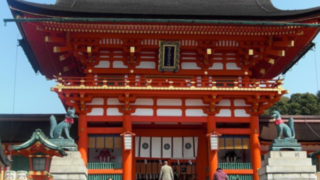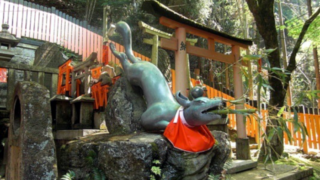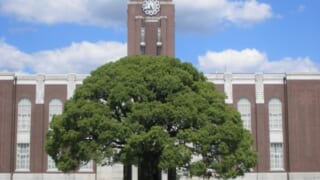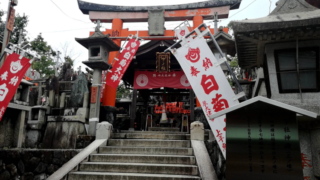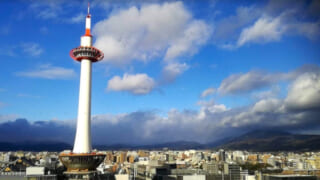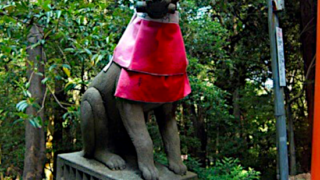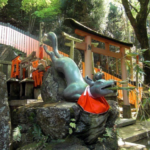This is an introduction to Fushimi Inari Shrine, one of Kyoto’s most representative and beautiful landscapes.
This is the second installment, and we will introduce the process of the “O-yama Meguri” (mountain tour) from the shrine precincts with the main hall, through the Senbon Torii (Thousand Torii Gates), Shin-ike Pond, and Mitsu-tsuji, all the way to Yotsu-tsuji.
Please see the first installment below.
- Torii Gate from the Main Hall to the Inner Shrine, and the Sub-shrines
- Go-sha Aido-sha (Five-Shrine Combined Hall)
- Ryogu-sha Shrine
- Tamazan-sha Shrine
- Shinme-sha (Sacred Horse Stable)
- Shirakko-sha (White Fox Shrine) and Oku-no-miya (Inner Shrine)
- Senbon Torii (Thousand Torii Gates) Entrance
- Oku-no-in (Inner Shrine)
- Omokaru-ishi (Heavy-Light Stone)
- Oku-no-in Ema (Prayer Plaques)
- Oku-no-in Mount Inari Map
- Path Continuing North from Oku-no-in
- Shinpou Shrine – Takenoshita-michi
- Shinpou Shrine (Fushimi Shinpou Shrine)
- Shinpou Shrine – Kanae-hina
- Neagari no Matsu (Raised-Root Pine)
- Path from Oku-no-in
- Junction to Kumadaka-sha Shrine from Oku-no-in
- Path to Kumadaka-sha Shrine
- Kumadaka-sha’s Otsuka (Sacred Mounds)
- Shin-ike (Kodama-ga-ike) Pond
- Kumadaka-sha Shrine
- Path from Kumadaka-sha Shrine to Mitsu-tsuji
- Mitsu-tsuji (Three-way Intersection)
- Mitama-tei Tea House
- Kyoya Tea House – Enoki-sha Shrine
- Hyotei Tea House
- Daimatsu-sha Shrine
- Santoku-tei Tea House – Santoku-sha Shrine
- Observation Deck Before Yotsu-tsuji
- Stairs to Yotsu-tsuji
Torii Gate from the Main Hall to the Inner Shrine, and the Sub-shrines
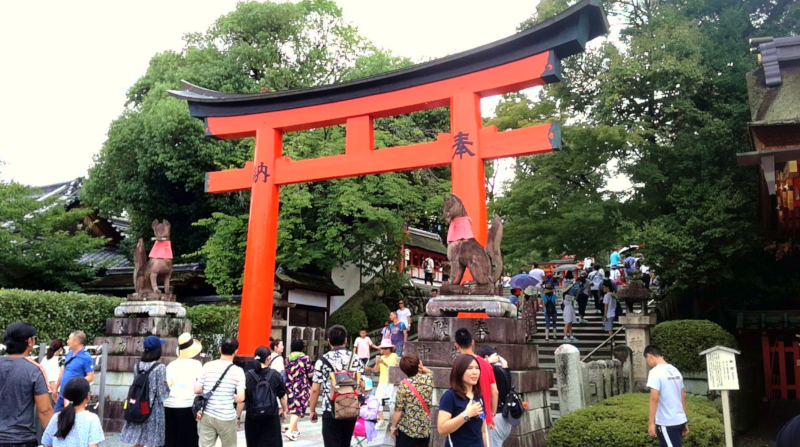
Passing through the torii gate behind the main hall of Fushimi Inari Taisha, you will exit the main precincts. In the back, you will find sub-shrines of Inari Taisha, the corridor of the Senbon Torii, and the entrance to Mount Inari.

Immediately after passing through the torii gate, on the left side at the top of the stairs, you will find the sub-shrines of Fushimi Inari Taisha.
They enshrine deities associated with Fushimi Inari Taisha.
Left: Choja-sha Shrine, Enshrined deity: Ancestor of the Hata clan (the former priestly family of this shrine)
Right: Kada-sha Shrine, Enshrined deity: Ancestor of the Kada clan (the former priestly family of this shrine)
There are two lineages of Shinto priests (shakae) at Fushimi Inari Taisha: the “Hata clan” and the “Kada clan.”
These Choja-sha and Kada-sha shrines also appear later in the mountain tour, but you can actually visit them this close without having to climb the mountain.
Go-sha Aido-sha (Five-Shrine Combined Hall)
This is one of the sub-shrines behind the main hall.

Ebisu-sha Shrine: Kotoshironushi no Kami
Takeo-sha Shrine: Susanoo no Okami
Wakaouji-sha Shrine: Jakuouji no Okami
Hiyoshi-sha Shrine: Oyamakui no Kami
Hachimangu-sha Shrine: Emperor Ojin
As mentioned earlier, the main hall is also a “Go-sha Aido-sha” (Five-Shrine Combined Hall), and this sub-shrine is also an Aido-sha. It is interesting to see famous deities you may have heard of being enshrined as sub-shrines of Inari Taisha.
Ryogu-sha Shrine

Enshrined deities: Amaterasu Sumeramio-kami, Toyouke Sumeramio-kami
The supreme deities of Japan, enshrined at the Inner and Outer Shrines of Ise Grand Shrine, are enshrined here.
They are said to have a deep relationship with the Inari deity.
Tamazan-sha Shrine
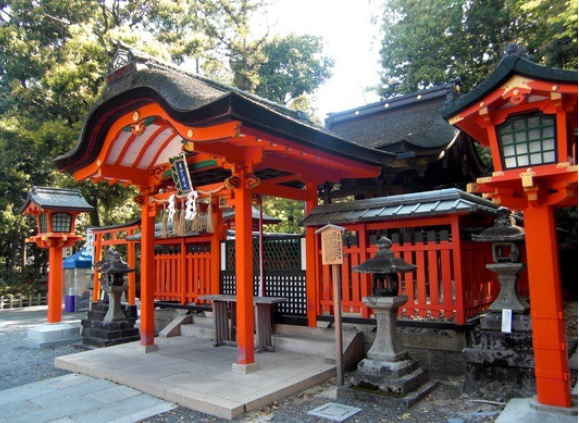
After passing by the temporary main hall (Gonden) and the shrine office, and going up the stairs past the sub-shrines, you will see Tamazan-sha Shrine directly in front of you.
The current inner shrine used to be here, but it was relocated to its current position in the Genroku era. In its place, Tamazan Inari Okami was enshrined. Tamazan Inari Okami was originally invited to protect the Imperial Court and was enshrined within the Kyoto Imperial Palace, but was relocated to its current location in 1871 due to the transfer of the capital to Tokyo.
Shinme-sha (Sacred Horse Stable)

This is the Shinme-sha, where the Shinme, a sacred horse that serves as a deity’s vehicle, is dedicated.

Shirakko-sha (White Fox Shrine) and Oku-no-miya (Inner Shrine)
The Shirakko-sha is on the front left after climbing the stairs.
The enshrined deity is Myobu Tome no Kami.
Myobu was a general term for middle-class court ladies who served in the Imperial Court during the Heian period. It eventually came to refer to the miko (shrine maidens) serving at Inari shrines, and from the medieval period, it came to mean the fox, the divine messenger of Inari.
At Inari Taisha, you can see foxes, the divine messengers, everywhere. They are said to convey the words of the gods and the laws of nature to us, while also watching over our lives.

Next to the Shirakko-sha is the Oku-no-miya (Inner Shrine).
The enshrined deity is “Inari Okami.”
It is a “San-sha Aido-sha” (Three-Shrine Combined Hall) and is said to have been built around the same time as the main hall. It is called the Oku-no-miya because it is located behind and higher up from the main hall.
Therefore, it is considered a shrine with a long and respectable history, enshrining the same deity as the main hall and being associated with the three shrines of the three peaks.
Senbon Torii (Thousand Torii Gates) Entrance

Next to the Oku-sha (Inner Shrine), there is the entrance to the “Senbon Torii.”
The Senbon Torii is a passageway to the Inner Shrine in Myobu-dani Valley, and as its name suggests, countless torii gates stand in a vermilion-colored corridor.
Its beautiful and unparalleled scenery makes it a popular spot for both Japanese and foreign tourists.

Along the way, the corridor splits into two paths, but both lead to the Inner Shrine.
When climbing from the bottom, it is recommended to take the left path, and when descending from the Inner Shrine, it is better to take the right path. In other words, it is a left-hand traffic. A pair of foxes awaits you at the fork.
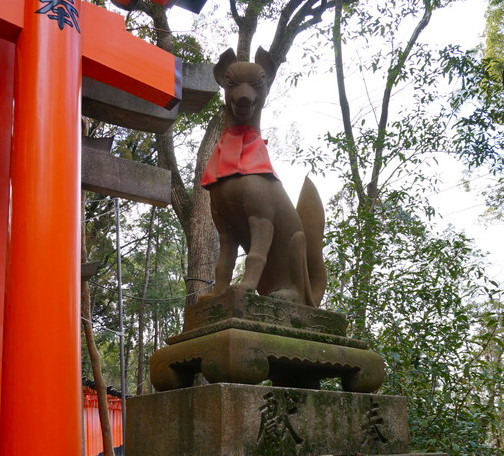
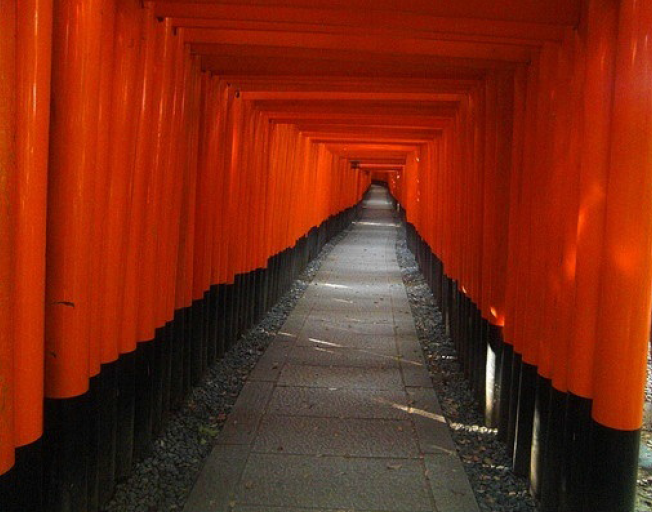
This is a corridor with a vanishing point far in the distance. This scenery is the true essence of Fushimi Inari’s unique Senbon Torii. You can’t help but feel as if you are in an endless vermilion corridor. At night, the lights come on and it is illuminated.
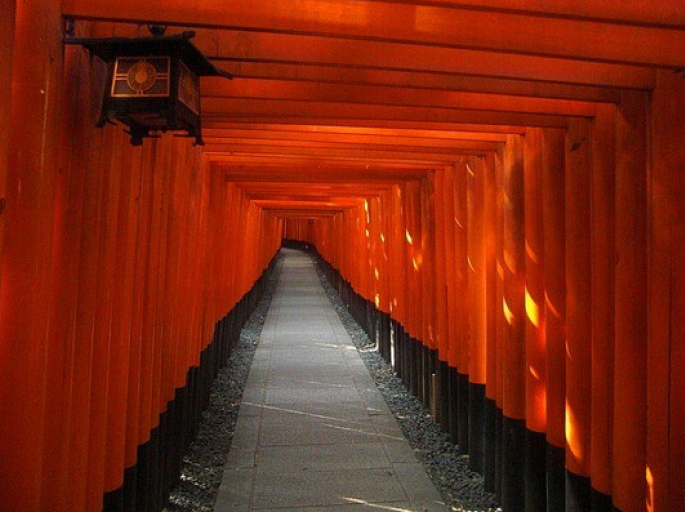
The vermilion color changes depending on the light.
Passing through this vermilion torii corridor is said to purify you from the defilements of the mundane world before you reach the Inner Shrine.
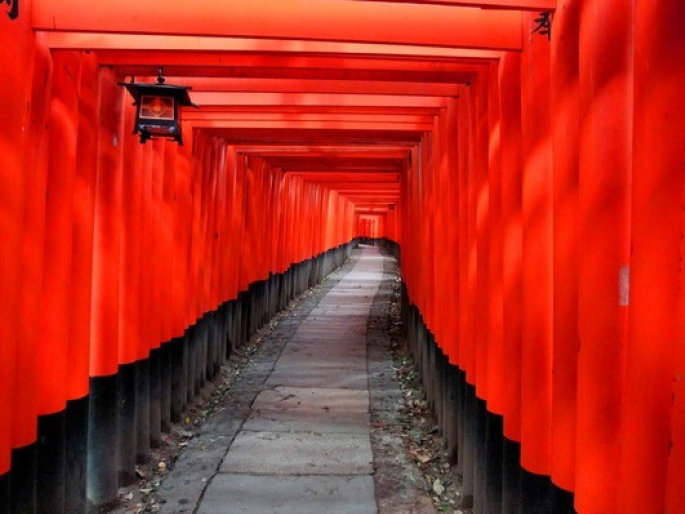
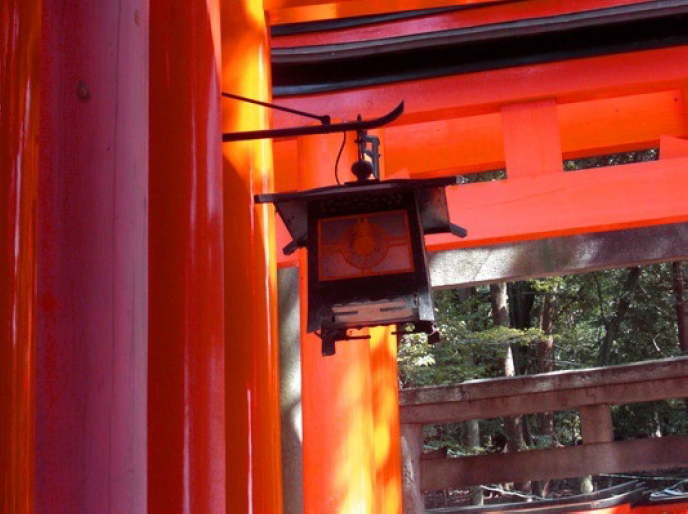

Looking at the back, you can see the name and address of the person or company that dedicated the torii, and the date of dedication.
The addresses are not only from the Kansai region, but from all over Japan. Also, many of the torii were dedicated relatively recently, since the Heisei era.
The cost (hatsuhoryo) of a torii is listed on the Fushimi Inari Shrine’s website, and it can range from 170,000 yen for a small one to over 1.3 million yen for a large one.
This shows that the divine favor of the god of business prosperity has reached all parts of Japan.
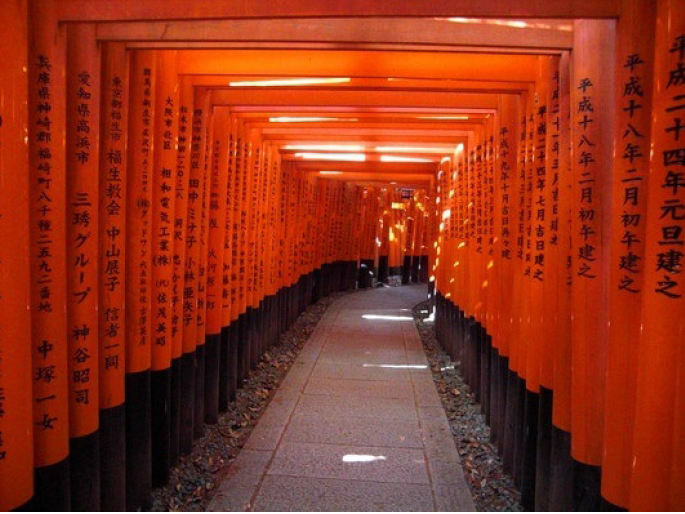
Oku-no-in (Inner Shrine)

After passing through the Senbon Torii, you will arrive at the Oku-sha Hono-sho, commonly known as the “Oku-no-in.”
This area is called Myobu-dani Valley, so the Oku-no-in is also called Myobu-sha.
“Myobu” was a female court official who served in the Imperial Court, and is also an alternative name for the fox, the divine messenger of Inari.
Behind the main hall is a torii that marks all of Mount Inari as a sacred body.
Here, you can pay homage to the three peaks of Inari.

The sacred body is Mount Inari itself, which rises behind the shrine, but a sacred rock wrapped in a shimenawa rope is enshrined under the torii.
Omokaru-ishi (Heavy-Light Stone)
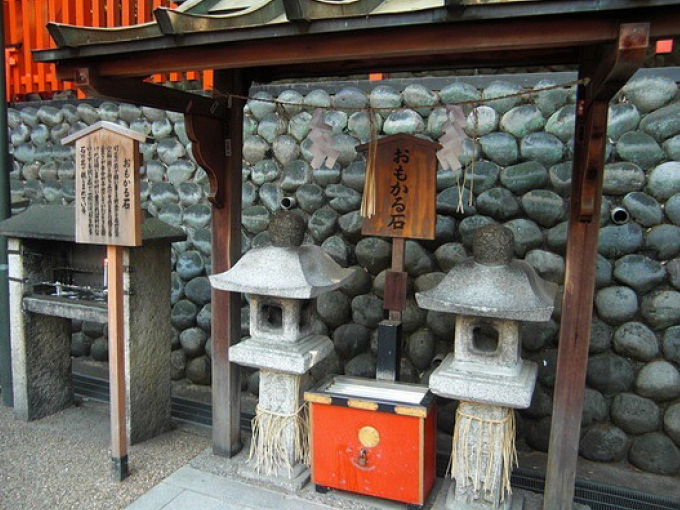
In the back right of the Oku-no-in, there is a stone lantern called the “Omokaru-ishi.”
It is said that if you lift the “Omokaru-ishi” and it feels lighter than you expected, your wish will come true; if it feels heavier, it will not.
Oku-no-in Ema (Prayer Plaques)

Here, they sell ema (votive plaques) shaped like fox faces instead of the usual ones.
You can write your wish and the fox’s expression on it and dedicate it. There seem to be many unique and interesting writings.
Oku-no-in Mount Inari Map

A map of Mount Inari is displayed.
The Mount Inari tour course is about 4km long (one ri) and takes about 2 hours.
There are ups and downs, so it’s a good workout to complete the loop.
Some people even come here for a morning jog.

This is the 2013 version of the Mount Inari map at the Oku-no-in. This is what the map looked like in 2013.
Path Continuing North from Oku-no-in
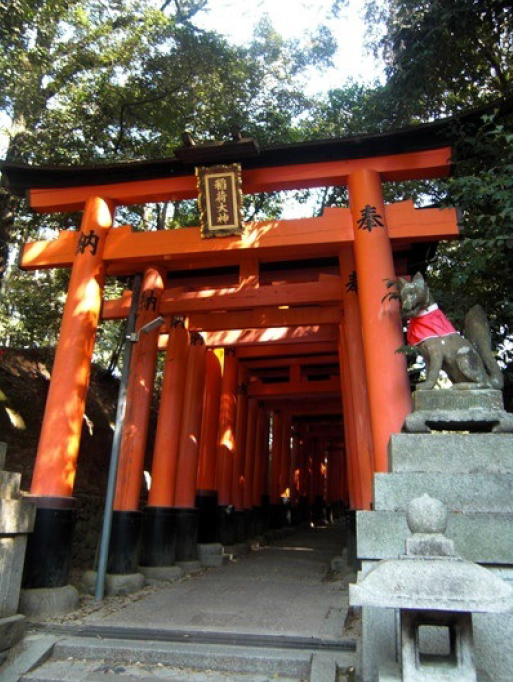
The torii corridor continues further into the back.
This is where the “O-yama Meguri” (mountain tour) course begins.
The distance is about 4km, the summit is 233m above sea level, and it takes about 2 hours, so not many people continue past this point.
However, the true essence of Fushimi Inari can be found in the “O-yama Meguri” on Mount Inari.
Beyond this point, a slightly different world of Mount Inari unfolds, and this Myobu-dani Valley is the starting point for the mountain tour.
Shinpou Shrine – Takenoshita-michi

Taking a side path from the mountain tour torii path, you will connect to an old road called “Takenoshita-michi.”
In ancient times, it was considered a part of the Yamato-ji road that led all the way to Yamato.
The atmosphere surrounded by bamboo groves feels like it’s outside the torii’s sacred boundary, and the scenery becomes somewhat more open.

Shinpou Shrine (Fushimi Shinpou Shrine)
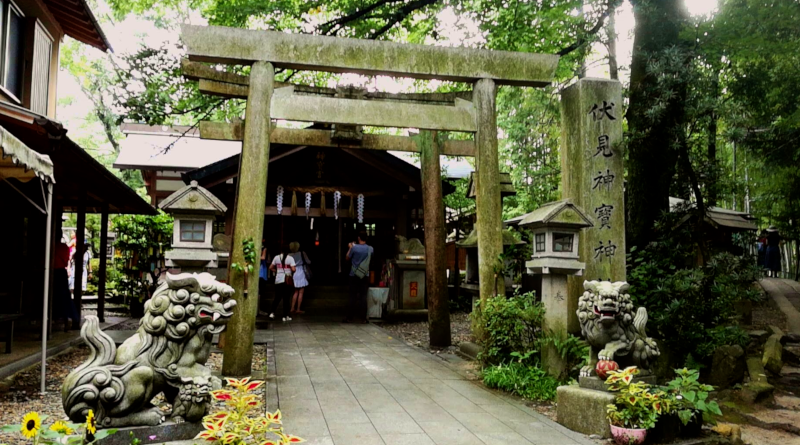
Shinpou Shrine is located at the foot of the old road.
The history of Shinpou Shrine is old, said to have been founded in the early Heian period and to have been a place of worship since the time when Inari Shrine was first established on the mountain. The enshrined deities are Amaterasu Omikami and Inari Daimyojin.
It is said that the “Tokusa no Kandara” (Ten Sacred Treasures), the secret treasures of the gods given by Amaterasu Omikami, are dedicated here. These are the following 10 sacred treasures.
Ten Sacred Treasures:
Okitsukagami, Hetsukagami, Yatsukanotsurugi, Ikutama, Tarutama, Makarukaeshinotama, Chikaeshinotama, Hebinohire, Hachinohire, Kusagusanomononohire
Shinpou Shrine – Kanae-hina

At Shinpou Shrine, paper dolls called “Kanae-hina” are dedicated.
It has long been said to bring good fortune for career advancement and matchmaking, and the colorful dolls adorn the side of the shrine.

Also, beautiful bamboo groves spread out on both sides of the Takenoshita-michi road beyond Shinpou Shrine.
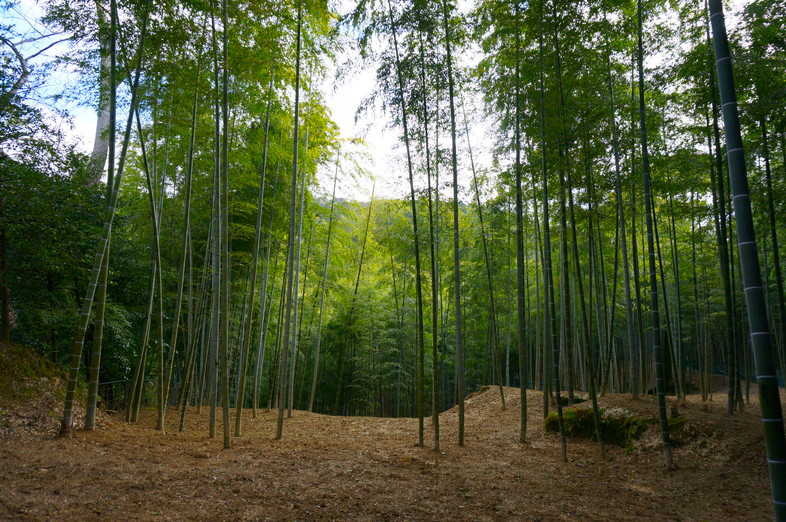
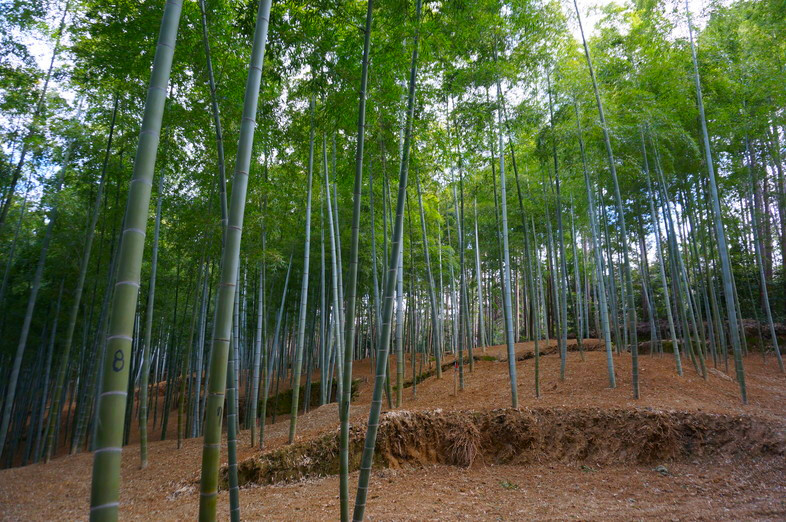
Further ahead, there are several waterfalls for ascetic training, and you can aim for the summit of Mount Inari, but we will introduce that route on another occasion.

We return from Shinpou Shrine to the main mountain tour path. As you can see in the photo, the torii corridor continues all the way, so you won’t get lost on the main route.
We’re going.
Neagari no Matsu (Raised-Root Pine)

Next to the path is the “Neagari no Matsu.” This photo is from 2013, and it has been given emergency treatment as the roots were about to break. As of 2019, the bandage is gone. It seems to have been fully reconnected after a “surgery” as shown in the picture below.
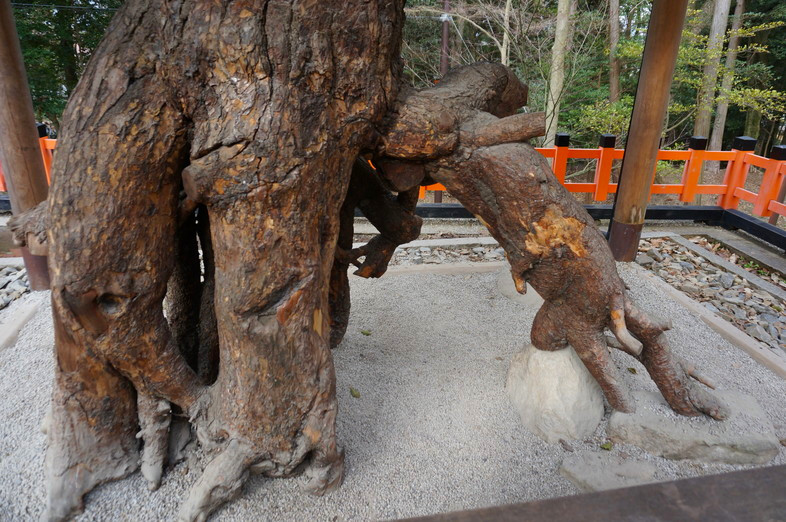
Now, about the origin of this Neagari no Matsu: it was named “Neagari no Matsu” because the pine’s roots have risen from the ground, forming a loop.
It is also called “Hiza-matsu-san” (Knee Pine), and it is said that passing under its roots is effective for leg and back ailments.
It is also said that its name, “neagari,” which can also mean “rise in value,” brings good fortune for a rise in stock prices or salaries.
Path from Oku-no-in
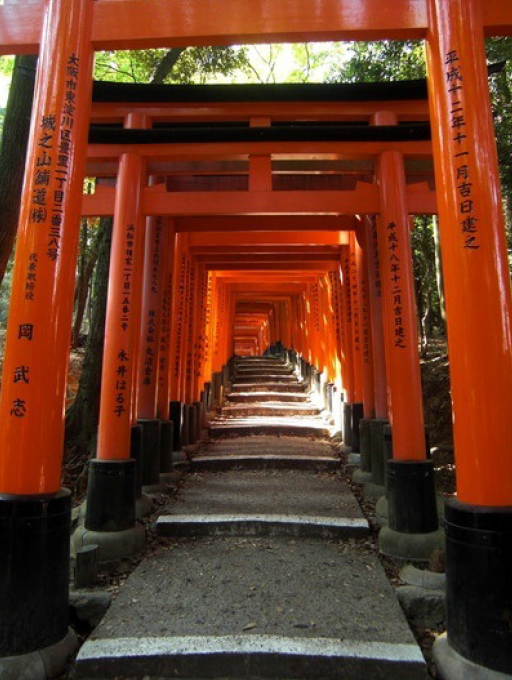
We return from the Neagari no Matsu to the original path.
This area has some ups and downs, but it’s the beginning of the mountain tour, so it’s not too physically demanding.
Also, since we’ve entered the mountain, the air feels a little cooler.
In any case, it’s an easy path to walk.

I heard the Heart Sutra along the way, so I strayed from the main path to get closer and found that a goma fire ritual was being performed. There are many shrines on Mount Inari, and depending on when you visit, a ritual may be taking place at one of them.
Junction to Kumadaka-sha Shrine from Oku-no-in

After a while, you will come to a fork in the road.
If you go left, you can return to the main hall via the Shin’en (Shrine Garden), Kamida (Sacred Rice Field), and Yashima Pond.
The path to the right is the mountain tour course.
It’s a flat path for a while, but it becomes an uphill climb after you pass the public restroom.

Path to Kumadaka-sha Shrine

Take a right at the fork and continue along the torii corridor for a while, and you will see a restroom on your right.
After the restroom, continue along the path with a small stream on your left.
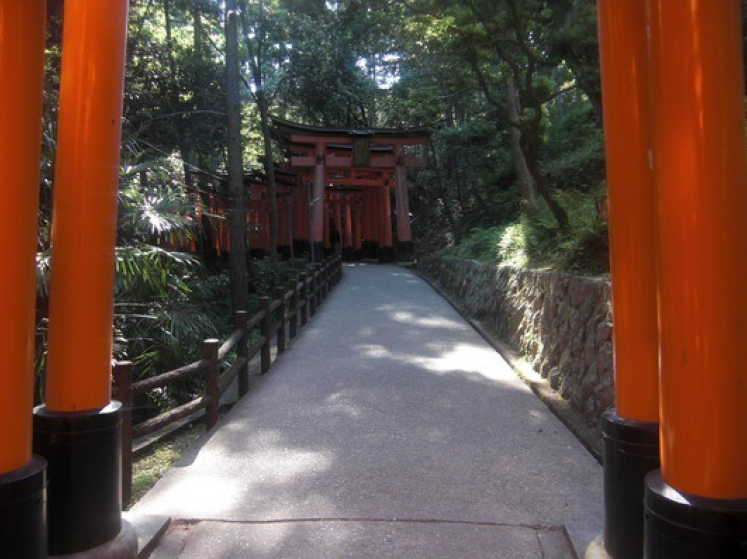
Kumadaka-sha’s Otsuka (Sacred Mounds)

As you climb the stairs before Shin-ike Pond, countless small shrines and torii gates suddenly appear before your eyes.
This is the “Otsuka” (sacred mounds) of Mount Inari, a group of sacred stones.
The chaotic scenery of the Otsuka clustered like terraced fields on the side of the mountain will undoubtedly make visitors stop in their tracks the moment they see it. A space with such a unique atmosphere spreads out. However, it can also be an eerie sight, so I would not want to enter it at night.

Shin-ike (Kodama-ga-ike) Pond

After passing through the Otsuka and climbing the stairs, a large pond spreads out before your eyes.
The pond is called Shin-ike Pond, and the Kumadaka-sha Shrine, which has a magnificent hall, stands on its shore.
Shin-ike Pond is also called “Kodama-ga-ike” (Echo Pond). It is said that if you clap your hands towards the pond and listen for the echo, you will get a clue about the direction of a missing person.
Kumadaka-sha Shrine

Kumadaka-sha Shrine is the first shrine you encounter on the mountain tour.
It is one of the largest on Mount Inari and is a very popular spot as the god of victory and business prosperity.
In front of Kumadaka-sha is “Takeya,” a shop founded in 1757 (Horeki 7), where they sell candles and torii gates to be dedicated to Kumadaka-sha.
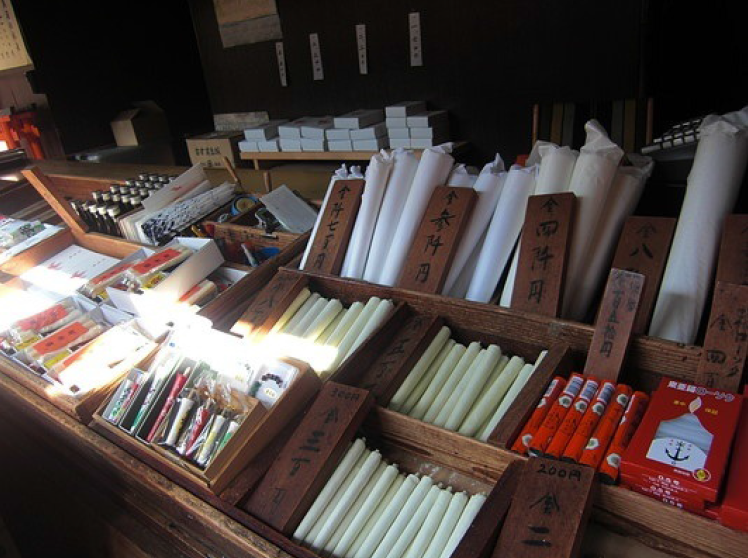
Kumadaka-sha Shrine is one of the most popular spots among the shrines on Mount Inari, as it is said to bring good fortune for business prosperity.

Shin-ike Pond viewed from Kumadaka-sha Shrine.


This is where the torii gates purchased at Takeya are dedicated.
Many torii gates with wishes are displayed here.
Path from Kumadaka-sha Shrine to Mitsu-tsuji
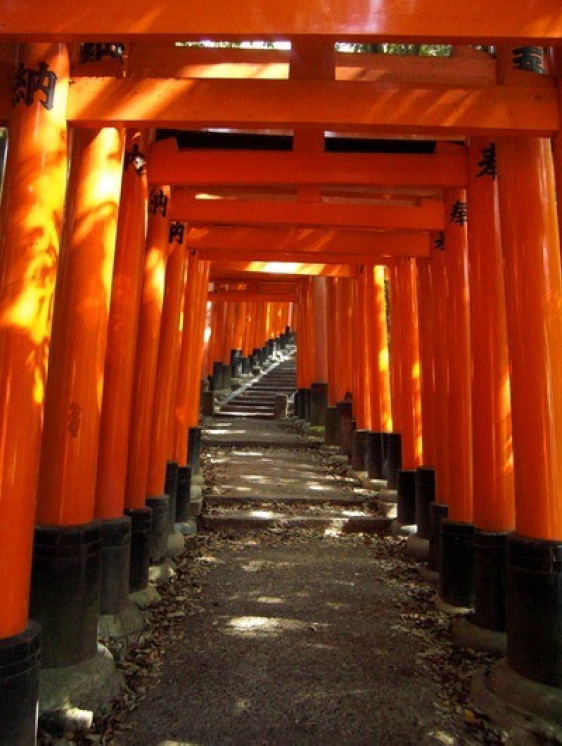
We continue further from Kumadaka-sha Shrine.
The path becomes steeper, and the continuous stairs make you short of breath.
However, if you look to the side, the sunlight filters through the torii gates, creating a beautiful contrast of green and orange.
Mitsu-tsuji (Three-way Intersection)

You will eventually come to a T-junction.
It is called Mitsu-tsuji, and as its name suggests, the road splits into three directions.
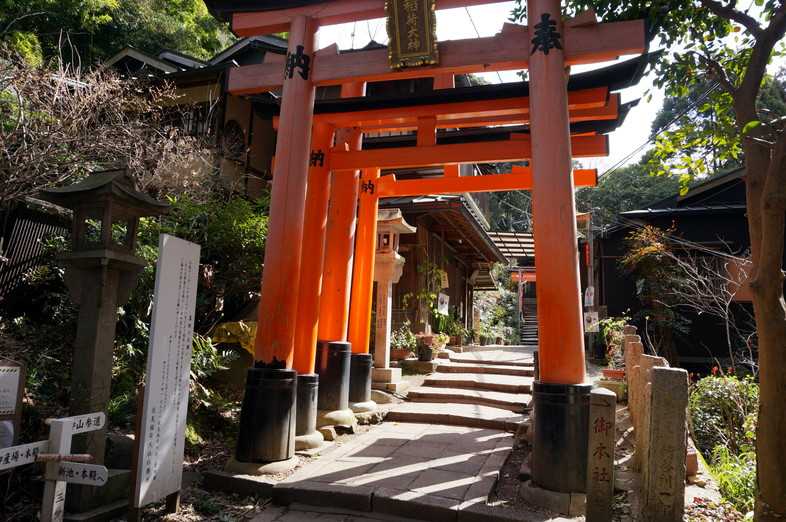
The path to the right is the mountain tour path that leads to Yotsu-tsuji.
The path to the left is the back path that leads back to the foot of the mountain.

Mitama-tei Tea House
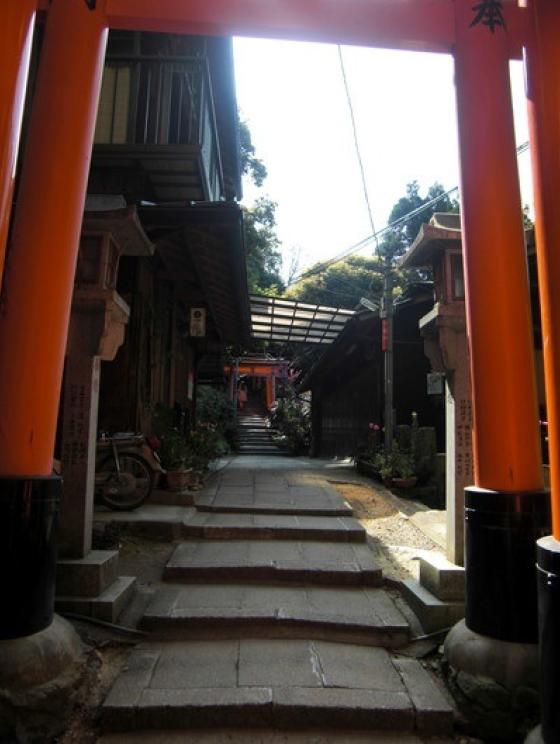
If you proceed from Mitsu-tsuji and pass through the torii gate, you will suddenly come to a place with a nostalgic, downtown-like atmosphere.
You are temporarily released from the long path surrounded by green and vermilion torii, and it suddenly becomes lively.
Here, you will find a tea house called Mitama-tei.
You can rest your tired body or have a meal here.

Along the mountain tour, you will find such tea houses next to the shrines, where you can have not only tea and juice but also meals like kitsune udon and soba.

This photo is from July 2019. It might have been before they opened, as it was in the morning.
Kyoya Tea House – Enoki-sha Shrine

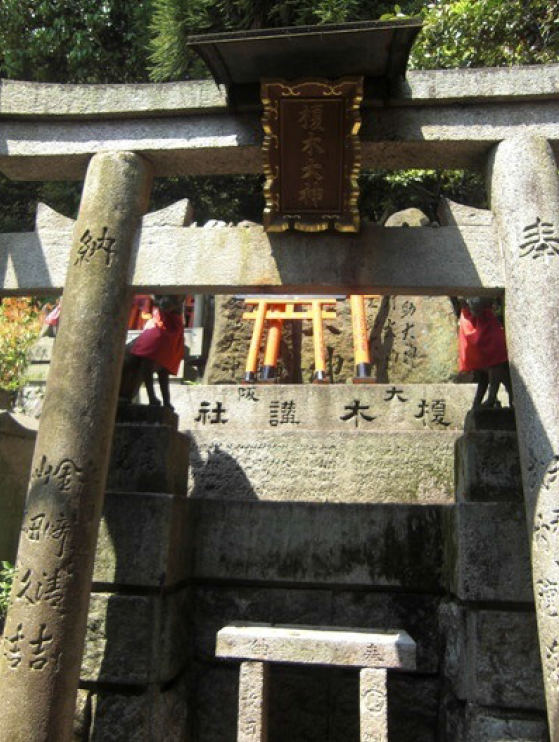
If you go up the stairs from Mitama-tei, you will immediately find a tea house called “Kyoya.”
It has a large tatami room where you can have kitsune udon, nishin soba, inari sushi, and more. In front of Kyoya is the Enoki-sha Shrine.
Hyotei Tea House
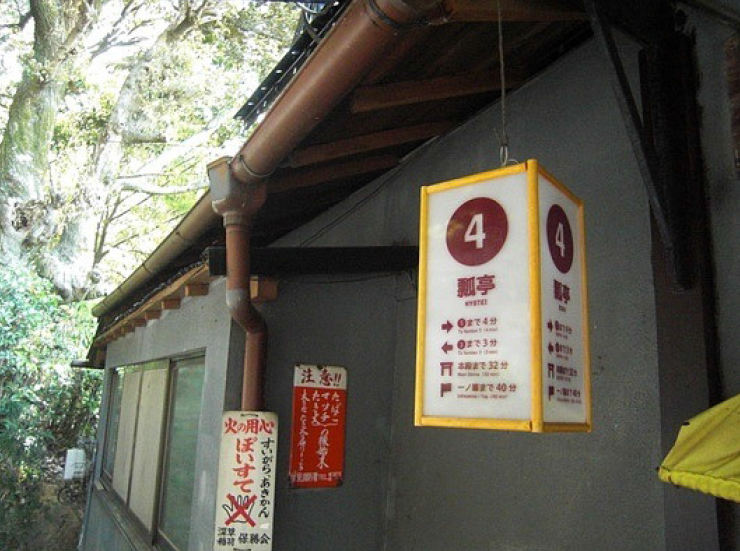
From Enoki-sha, if you climb the stairs for a while, you will see a tea house with a unique name, “Hyotei,” on your right.
The “Hyo” in Hyotei refers to “hyotan,” a gourd.
Daimatsu-sha Shrine


At Daimatsu-sha Shrine, there is a giant sacred object shaped like a gourd (hyotan). This is the reason why the tea house in front of it is called “Hyotei.”
Santoku-tei Tea House – Santoku-sha Shrine

Continuing up the stairs, you will see “Santoku-tei” on your right and “Santoku-sha” on your left.
Santoku-sha has a magnificent shrine hall and is said to bestow the three virtues of the Inari deity: “chi” (wisdom), “jin” (benevolence), and “yu” (courage).

Observation Deck Before Yotsu-tsuji
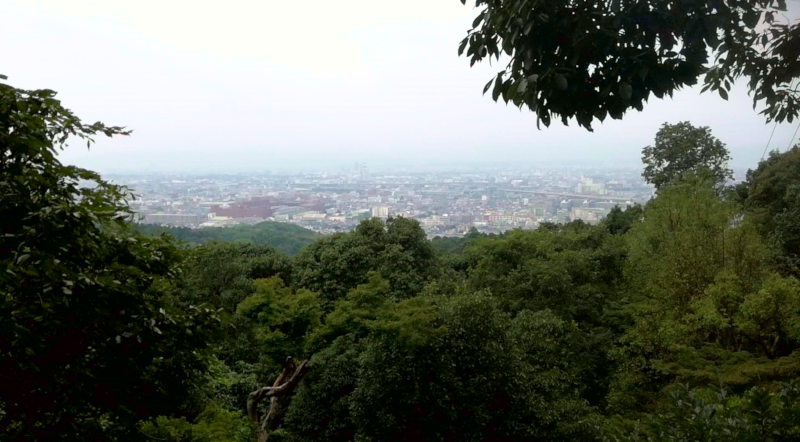
Just before Yotsu-tsuji, there is a landing from which you can get a panoramic view of the Fushimi area of Kyoto. It’s a bit hard to see, but you can see Ryukoku University in Fushimi Ward and the elevated expressway.
Stairs to Yotsu-tsuji

A steep set of stairs continues for a while.
You might want to climb them all at once, but both the number of steps and the gradient are quite challenging, and you will become out of breath. Take your time and climb one step at a time.
Turn to the left and pass through a torii gate, and you will reach Yotsu-tsuji, an observation deck and rest area with a great view.
This concludes the second installment. The third installment will follow.
